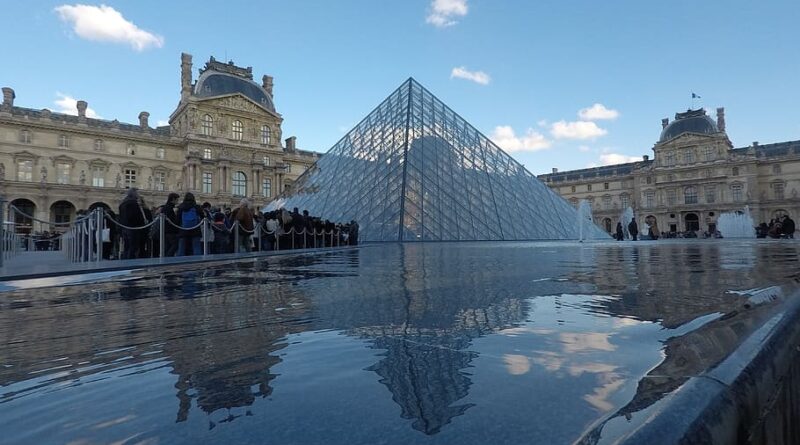Louvre Pyramid, Paris, France
Illuminating Paris: The Louvre Pyramid’s Enduring Legacy
In the heart of Paris, where history, art, and innovation converge, stands an iconic structure that has become synonymous with one of the world’s most renowned museums—the Louvre Pyramid. This remarkable architectural marvel, born from the union of ancient grandeur and modern aesthetics, has captured the imagination of millions of visitors. Its crystal-clear geometry and artistic significance have transformed the Louvre’s entrance into an art form of its own. In this article, we embark on a journey to explore the history, design, controversies, and lasting impact of the Louvre Pyramid, a beacon of artistic fusion and symbol of Paris’s enduring allure.
A Marriage of History and Modernity
The Louvre Pyramid, a striking glass and metal structure, stands as a grand entrance to the historic Louvre Museum, itself a former royal palace. Designed by acclaimed architect I. M. Pei, the pyramid was unveiled to the world on March 29, 1989. This audacious addition to the Louvre complex sparked both admiration and debate, as it boldly juxtaposed modern architecture against the backdrop of the museum’s classical façade.
The pyramid’s installation marked a transformative moment, signaling the Louvre’s intent to marry tradition with modernity while offering visitors a contemporary entry point to the treasure trove of art and culture within.
The Geometry of Beauty
The Louvre Pyramid’s design is a triumph of geometry and light. Comprising 603 rhombus-shaped and 70 triangular glass segments, the pyramid stands as a three-dimensional puzzle that challenges the eye and stirs the imagination. The structure’s transparency allows natural light to infiltrate the underground entrance, creating a dramatic interplay between light and shadow—a metaphor for enlightenment itself.
The pyramid’s precise alignment with the historical axis of Paris and the Louvre’s Cour Napoléon adds to its symbolism, blending past and present with an understated grace that captures the essence of the city itself.
Controversies and Critics
As with many groundbreaking architectural creations, the Louvre Pyramid was not without its share of controversies and critics. Some Parisians initially viewed the pyramid as an intrusion on the Louvre’s timeless elegance. The bold departure from the Louvre’s traditional architecture was met with skepticism, and the pyramid’s glass and steel exterior initially seemed at odds with the surrounding structures.
However, over time, the Louvre Pyramid’s detractors evolved into admirers, as the juxtaposition between classic and modern architecture became a testament to the museum’s ability to adapt and embrace new ideas while preserving its historical significance.
A Triumph Over Time
The Louvre Pyramid’s journey from controversy to cherished symbol is a testament to its enduring impact. As visitors and art enthusiasts from around the world converged on the Louvre, they discovered that the pyramid’s design not only harmonized with its surroundings but also offered an innovative gateway to the museum’s vast collection.
The pyramid’s success in blending the old with the new marked a turning point in architectural thought. It encouraged a new generation of architects to explore the potential for synergy between historical and contemporary elements in urban spaces.
A Global Symbol of Culture
The Louvre Pyramid’s resonance extends beyond the realm of architecture. It has become a global symbol of culture, art, and human creativity. The iconic image of the pyramid against the backdrop of the Louvre evokes a sense of wonder and curiosity, inspiring individuals from all walks of life to engage with the world of art and ideas.
The pyramid’s glass panels, reflecting the sky and the city’s surroundings, are metaphors for the way art itself reflects and refracts the myriad perspectives that make up the human experience.
A Nexus of Art and Innovation
The Louvre Pyramid’s impact extends beyond its role as an architectural adornment. It serves as a nexus where art and innovation converge. The pyramid’s technological marvels include the use of lightweight materials, precision engineering, and innovative glass techniques. These elements symbolize the union of artistic expression with the possibilities of modern technology.
Inside the Louvre, visitors encounter the same fusion, as the museum’s collection spans centuries and genres, celebrating the boundless creativity of humanity across time and space.
Conclusion
The Louvre Pyramid stands as an enduring symbol of Paris’s commitment to the intersection of tradition and progress. Its crystalline geometry and transparency capture the essence of art itself—illuminating the world with beauty, challenging perceptions, and inviting exploration.
From its controversial inception to its present status as a beloved landmark, the Louvre Pyramid represents the power of architecture to shape perception and influence thought. As visitors gather before its gleaming façade, they are reminded that art, like the pyramid, is a multifaceted prism that reflects the infinite facets of human imagination. In its profound simplicity and grandeur, the Louvre Pyramid invites us all to embark on a journey of discovery, transforming the act of entering a museum into an artistic experience in its own right.



